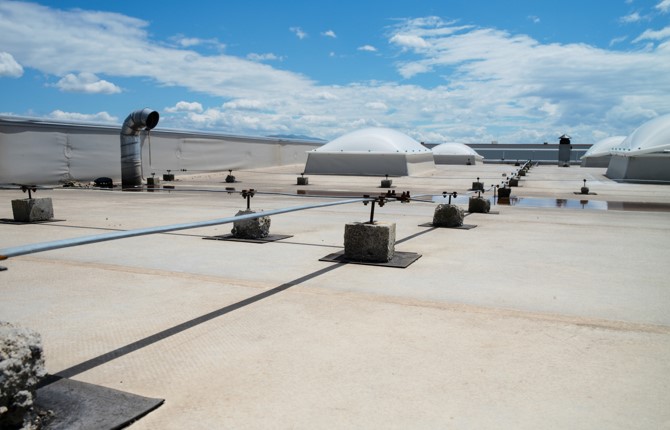Roof Cooling In Focus As Telangana Leads With Policy For Buildings

The Telangana government in India recently launched its Roof Cooling Policy (CPR) for 2023-28. With this, it became one of the few Indian states to step in this direction. As per the mandate of the government policy, all government and non-residential buildings with more than 600 yards are bound to make arrangements for cooling their roofs.
It includes retrofitting their roof surfaces to increase their potential to reflect more sunlight falling onto their surface and reduce heating. The state government has targeted a cool roof area of up to 300 square kilometers by 2028.
The policy paper claimed that with the cooling roof interventions, the building occupants could reduce their indoor room temperatures to anywhere between 2.1 degrees Celsius to 4.3 degrees Celsius. At the same time, they can also mitigate around 20 percent of energy costs needed for extra cooling. The policy push is especially welcome in a country where extreme summer heat is no longer an uncommon issue, and made worse by the unaffordability of cooling solutions like air conditioners for a vast majority of the affected population.
What is cool roofing?
Cool roofing refers to mechanical interventions to increase the potential of the roofs to reflect the sunlight falling into them. The reflective potential of the roofs is measured as the ‘solar reflective index.’ Experts claim that any intervention that can help boost the roof surface’s reflective index can cool down the room temperature, which can help consumers use less energy in buildings.
Documents from the Bureau of Energy Efficiency (BEE) claimed that around 30 percent of the country’s energy is used to cater to the energy needs of buildings. Similarly, a report by the International Energy Agency (IEA) claimed that currently, around 20 percent of the power used in households across the globe is used in cooling systems. This is a figure expected to only rise in the days to come, as warming accelerates especially in an ill prepared developing world. The same report claimed that by 2050, around 2/3 of the world’s households could have (or would need) an air conditioner. The report said China, India, and Indonesia would account for half the total.
The US Department of Energy defines a cool roof as “Designed to reflect more sunlight than a conventional roof, absorbing less solar energy. As a result, it lowers the temperature of the building. For example, conventional roofs can reach temperatures of 150°F or more on a sunny summer afternoon. Under the same conditions, a reflective roof could stay more than 50°F (28 °C) cooler. It can save energy and money in buildings with air conditioning, or improve comfort and safety in buildings without air conditioning, by reducing heat flow from the roof into the occupied space.”
The Indian government’s Energy Conservation Building Code (ECBC) 2017 also proposes increasing commercial buildings’ energy efficiency by boosting roofs’ insulation. The ECBC code also discusses providing cool roofs on rooftops without solar panels. The ECBC code has also mandated standards for cool roofs.
The ECBC, while talking about the cool roofs, said, “For qualifying as a cool roof, roofs with slopes less than 20° shall have an initial solar reflectance of no less than 0.60 and an initial emittance no less than 0.90.” The ECBC applies to most of the large commercial buildings in India; however, several states are yet to notify their rules under ECBC, delaying the mandatory compliance of such provisions.
How to cool down roofs?
There are different ways that can be deployed to cool down roofs. These are also one of the simplest and most cost-effective measures to fight the heat, especially in urban areas. Some of the measures could be-
1. Coated roofing: Here, the rooftops could be painted/coated with acrylic polymers and other means to increase the solar reflective index of the surface.
2. Membrane cool roofs: Under this model, a membrane-like pre-fabricated sheet like PVC or bitumen could be put on the surface to help it cool down during harsh sunny days.
3. Tiled cool roofs: Here, specific tiled surfaces are joined on the roof surface to increase the reflective index of the roofs so that less quantum of sunlight gets absorbed by the surface. It could be with albedo ceramic mosaic tiles or shingle tiles on the existing roof.
With the rise of energy requirements, it is pertinent to increase energy efficiency to reduce electricity consumption, which is still dominated by coal-fired thermal energy in India, leading to the emission of greenhouse gasses. In the last eight years, the per capita electricity consumption has increased and is only likely to escalate. While it was 914 kWh in 2012-13, it touched 1208 kWh in the last fiscal, an increase of 32 percent, data from the government claimed.




